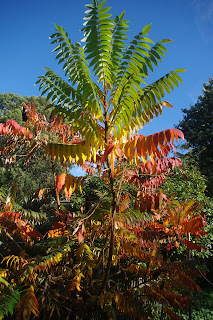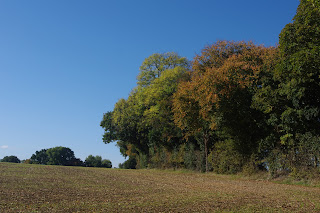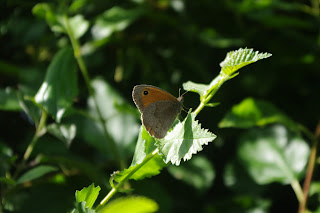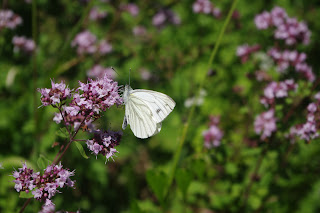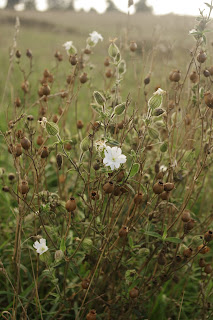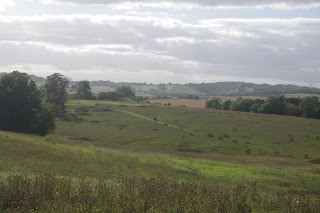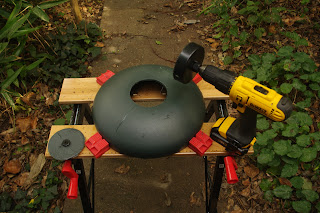Autumn colours: Fig Trees take on a yellow glow as the leaves turn.
A diary of back garden botany, urban ecology, rural rambles and field trips to the middle of nowhere...
Friday, 28 October 2022
Thursday, 27 October 2022
Mulching serves multiple purposes: it improves the soil as it breaks down, suppresses weeds to some extent and helps retain moisture. By mulching I mean a covering of organic matter. One such I rarely see utilised is pine needles.
I happen to have a ready supply of them and generally use them for mulching around the raspberry canes on the allotment. Raspberries like a slightly acidic soil and pine needles are somewhat acidic which I've always assumed is a good pairing. Unfortunately research on the subject suggests they have no appreciable effect on soil PH so scratch that theory.
Never mind, they still make a good mulch. In the States it's known as 'pine straw mulch'; no doubt the vast pine forests make it a resource too good to overlook.
Tuesday, 25 October 2022
Bumblebees still come out to forage on the milder autumn days. Honeybees can't function if temperatures are much below 10℃ but bumblebees are furry. It is thought that bumblebees may have originated in the Himalayas and Hegduan Mountains about 35 million years ago.
Recently I watched some truly remarkable footage from the BBC series Frozen Planet showing Lapland bumblebees emerging after nine months of hibernation. They can survive temperatures as low as -20℃ and feed on the wildflowers of the tundra in the short period when the landscape thaws.
Sunday, 23 October 2022
Friday, 21 October 2022
Yarrow (Achillea millefolium) flowers from July onwards well into October. The white form is a common weed/wildflower of grassy places.
The pink variation is slightly less common but still widespread. I saw both growing in the verges outside the village of Gosmore at the junction of Thistley Lane and Half Handkerchief Lane. I can guess how the former got its name but what is the legend of the Half Handkerchief?
Thursday, 20 October 2022
Wednesday, 19 October 2022
Walking in Hertfordshire yesterday I planned a route that took in both Wain's Wood and Hitch Wood. Oak, Hornbeam, Beech and Ash are among the species present in these pockets of ancient woodland.
In spring they are carpeted with Bluebells but autumn is enchanting in a different way. Damp, musty leaves scrunched underfoot. Bright sun shone overhead but the forest floor was dark, illuminated here and there by shards of light. The air was still and the woods were silent.
Sunday, 16 October 2022
Greater Periwinkle (Vinca major) is not a difficult plant to propagate. In fact it propagates itself very nicely. A few years ago I planted a pot of V. major in a tough spot (dry, shady) and it is what Margery Fish would call "a ramper". Wherever the lax stems touch the ground they root and create a new clump which throws out more stems.
There is another tough area under a Sumach tree (Rhus typhina) where I would like some ramping to take place so I dug up one of the outlying clumps to go there. As you can see the stems are already seeking somewhere to root. Greater Periwinkle is noted as a good groundcover under trees and around shrubs.
The trick with transplanting is to get a decent amount of root. Some plants are sensitive to root disturbance but most do fine if they are relocated immediately. Periwinkles are so tough and hardy it takes a lot to deter them.
For good measure I also added a clump of the Intermediate Periwinkle (Vinca difformis). This was a sprig of stem and root that I potted up a year or two back. Without any care or attention it is clearly ready to ramp.
V. major flowers in early spring; V. difformis even sooner as early as January. Should be masses of flowers before the Sumach comes into leaf in May.
Friday, 14 October 2022
Knotted Cranesbill (Geranium nodosum) is not a spectacular plant but there's a lot to be said for it. For one thing it will grow in deep, dry shade and will flower there. The flowers are not prolific at any one time but G. nodosum flowers for months from early summer to mid-autumn. The foliage is deciduous but present in at least three seasons and arguably semi-evergreen here in London. The leaves take on beautiful russet red tones in autumn.
It spreads- which is a good or bad thing depending on how you look at it. As one of the gardeners at the South London Botanical Institute said to me: "If you've got it you will never be rid of it". I look on that as a good thing. In fact I got a quantity of the species from the SLBI.
One of the their beds was becoming infested with G. nodosum and I was asked to weed it out when volunteering there earlier in the year. Fair exchange is no robbery so I kept all the "weeds", potted them up and planted them round the garden last week.
Wednesday, 12 October 2022
Autumn is here. Flowers are few and far between but in a sense "the fall" is even more vibrant than summer as the leaves change colour. The vine Virginia Creeper (Parthenocissus quinquefolia) is one of the first to go out in a blaze of glory.
Introduced from the forests of North America it's rampant rather than creeping and way more vigorous than the domestic scale of the typical English garden. On a train journey into London last week I noticed numerous fiery swathes of P. quinquefolia where it has jumped back walls and fences and made a break for it.
Monday, 10 October 2022
Knocking Hoe, the Pegsdon Hills and Barton Hills have featured in numerous entries this year. Besides the sweeping views they are great places for wildflowers and wildlife. Now managed as nature reserves they are surviving examples of chalk grassland, an important habitat.
They straddle the Hertfordshire/Bedfordshire border linked by the Icknield Way which makes for seriously good walking if nature is your thing. Some stretches of the Way itself are rich in flora and fauna and there are other smaller sites of interest nearby like Hexton Chalk Pit.
My home town of Hitchin is about an hour's walk away but discovering that a local bus runs through Pegsdon and Barton-le-Clay once a week has helped my perambulations considerably. As I don't have a car the challenge for me is how to get to the middle of nowhere by public transport. Often that means a train, a bus then start walking.
Last time I visited Dartmoor for example I found there was a bus that ran from Newton Abbot along the eastern flank of the moor on a Tuesday. I wonder if it still does? Rural routes are being axed left, right and centre. I have applied the train/bus/walk method in America but there public transport is even scarcer.
I remember wandering around Shasta City (actually a small town) trying to find the bus stop after hiking on Mount Shasta. I knew there was a sporadic service to the neighbouring town of Dunsmuir. An Amtrak passenger train stops there at midnight en route from Seattle to Los Angeles. About eight hours later it stops in Oakland where there's a shuttle to San Francisco.
I asked various good citizens if they knew where the bus stopped. The first person I asked was incredulous:
"There's a bus? Where are you trying to get to?"
"To Dunsmuir, to get the train to Oakland".
"There's a train? To Oakland??"
Eventually I spotted a man who I thought might be a fellow hiker though he looked pretty gnarly with an archaic rucksack. Turned out he was a hobo. He did indeed know where and when the bus stopped because he was heading to Dunsmuir to jump a freight train to Denver. Anyway he and I and a local teenager were the only passengers on the bus and we had a nice chat with the driver who seemed glad of the company.
Saturday, 8 October 2022
A compilation of some of this year's butterfly photos. Here is a Meadow Brown.
Marbled White
Red Admiral
All the above were seen in the Hertfordshire countryside except the Red Admiral in my front garden in London. My impression is that butterflies are faring reasonably well where there are areas of natural habitat e.g. chalk grassland, ancient hedgerows and woods. Less well in towns though gardens provide a mixed habitat that suits some species. In the capital butterflies are very scarce indeed, I was surprised by that last sighting.
The latest report from the charity Butterfly Conservation notes continuing alarming declines in various species. But it's not all bad news. For example this year's Big Butterfly Count recorded a 95% increase in the numbers of Commas in gardens, probably due to the long hot summer.
Tuesday, 4 October 2022
White Campion (Silene latifolia) is a common wildflower of field margins, hedgerows, waste ground etc. It flowers throughout the summer and this one is hanging in there with a few flowers even in October. The bladder-like seed pods continue to develop which elsewhere on the plant have dried out dry to form a vessel full of seeds.
S. latifoila is an example of a species that's on the cusp of being an annual, biennial or a short lived perennial depending on conditions. Red Campion (Silene dioica) is more reliably perennial but short lived. Both perpetuate themselves with copious self-seeding. Actually Red Campion is more of a pinkish colour. Where it grows near White Campion they sometimes hybridise to create a pale pink Campion.
I had always assumed that White Campion is scentless but I have read that it releases its fragrance at night to attract moths.
Sunday, 2 October 2022
On this crisp and breezy autumn day I took a stroll from the outskirts of Hitchin to the nearby village of Charlton. From childhood on I have walked these paths many times.
Bright sunlight played across the Chilterns beyond. I was reminded of those words written by A.E. Housman...
Into my heart an air that kills
From yon far country blows:
What are those blue remembered hills,
What spires, what farms are those?
But it's not all melancholy. The village pub in Charlton closed in 2015. There was a successful campaign to 'Save the Windmill' and it reopened recently so I stopped off for a pint.
Saturday, 1 October 2022
If we did more to harvest rainwater it could be put to good use in the garden, particularly in times of drought. I can see why water collection hasn't seemed like a priority here in the UK. We expect to have plenty of rain but that is not a given in times of climate change. Indeed the rain we do get may be of such intensity that we need to mitigate the risk of flooding.
Having had a water butt at my flat in London for some time I decided to install water storage on a larger scale in my father's garden in Hertfordshire. The butt I ordered came with its own stand but I also made a small platform from a couple of planks.
It was supplied with a diverter to connect a downpipe to the butt via a hose but I wanted to run the pipe straight into the top of the barrel. Accordingly I cut a hole in the lid.
In fact this one only holds 100 litres and will fill up quickly. In due course it will be connected to two others holding 350 litres each i.e. 800 litres in total. The roof sheds thousands of litres annually so that's a drop in the ocean so to speak but will come in useful during drier periods. The excess drains straight onto the garden by connecting a soaker hose to the overflow. Better that than going (literally) down the drain. NB It's possible to buy ready made soaker hoses but making lots of pin holes in an ordinary hosepipe amounts to the same thing.
The 350 litre barrels have been out of stock with all suppliers for months. It seems this year's drought created a run on them which is no bad thing if people's thoughts are turning to rainwater harvesting.
Subscribe to:
Comments (Atom)


